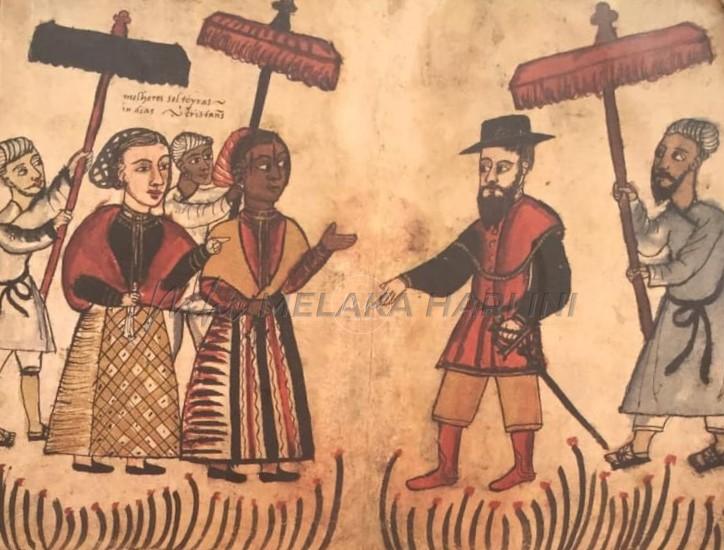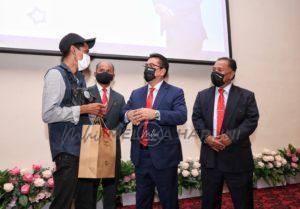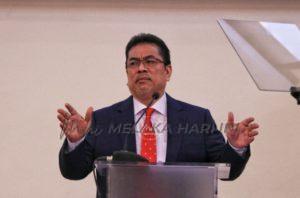
Atas Angin: Reflections of the Persian Cosmopolis on the ‘Lands below the Wind.’
The Bahasa Melayu term atas angin, literally ‘above the wind’ refers to regions and peoples westward. It is a Malay geographical and ethnic marker mainly referring to the Indian sub-continent, the Persian world, the Arabs and Turks. And extending to the European Mediterranean region.
Often, the peoples from the ‘lands above the wind’ formed at least semi-permanent communities along the coastal areas of the Malay Archipelago, seen in the many trading ports. The atas angin ethnicities are visible in the Archipelago, and these would primarily be Arabs and some of the major ethnicities from the Indian subcontinent, namely Tamils and Gujeratis (based on Malay classical texts). They formed new communities along the littoral areas east (and west) of the Indian Ocean. Portuguese historian Tome Pires who spent some three years in Melaka from 1512 mentions 1,000 Gujerati merchants, 4,000 Persians, Bengalis, Arabs, together with a sizeable number of Tamils.
These ethnicities, from the ‘lands above the wind’ held a significant and durable presence in the ‘lands below the wind.’ Dibawah angin is the other ethnic marker, often too, a form of self-identity for the Malays in the Archipelago.
The marker of “below the wind” could be derived from Malay encounters with the Persians as told in Ibn Muhammad Ibrahim’s narrative in The Ship of Sulaiman. It was suggested that bawah angin denotes a Persian identity marker for countries in the East, “…surely the most blessed of all these regions.”
The gaze from the ‘lands above the wind’ on the Malay Archipelago – from Iran, has been much been subdued by the Indianization/Sanskritization discourse. Tomáš Petrů in his article titled “‘Lands below the Winds’ as Part of the Persian Cosmopolis: An Inquiry into Linguistic and Cultural Borrowings from Persianate Societies in the Malay World” (Moussons, 2016) suggests the label ‘Persian Cosmopolis’ to describe the integration of the Malay Tanah Air into the greater cultural sphere.
The degree of Persian cultural impact in the maritime region reveals the intricacies of cultural pluralism and hybridization since time immemorial. The connection was intense. Remember our school history of ‘Sufi missionaries’ in Melaka, or the kingdom’s Gujerati harbor masters (Syahbandars)? The connections, bearing much on Malay collective understanding of society and civilization, have been almost effectively muted.
Links between Iran and the Archipelago happened roughly between the 11th and 19th centuries. According to scholars, the realm of the Persian cosmopolis was usually defined geographically as extending from Anatolia (indirectly via the Ottoman expansion) to central Asia to Bengal, and along the maritime trading routes to the Malay Archipelago. It can be said that the Persian cosmopolis to some extent replaced the Sanskrit cosmopolis that preceded Persianate culture.
Before the 11th century, one finds some of the earliest contacts through maritime trade route across the Indian Ocean. This refers to the Parthian traders, operating in the late 2nd and early 3rd centuries CE, engaging with international entrepots in the region. Accordingly Sassanid Persians (224-651 CE) made an impact. Their literary works were translated into Cham. They were said to be familiar with Sassanid cosmology, namely in the book of Anurshiwan, said to be sacred to the Chams. I was also told that the Muslim Chams in central Vietnam called themselves as Orang Bani. They claim origins from figure called Noursavan, said to be the Persian king Anurshiwan.
In the Malay Hikayats, we encounter Nushirwan Adil (Nushirwan the Just). Nushirwan Adil appeared in at least four hikayats, namely Hikayat Amir Hamzah (1380), Hikayat Muhamamd Hanafiah (1380), Taj al-Salatin (1603) and Sejarah Melayu (1612). In Hikayat Amir Hamzah, Nushrwan Adil was mentioned 49 times, while we find the name mentioned six times in Sejarah Melayu.
The hikayat (a story/account), is from the Persian hikāīat. The Malay hikayats such as Hikayat Amir Hamzah and Hikayat Muhammad Hanafiyah are adaptations or even direct translations from Persian. A certain degree of Shiite influence reveal itself amongst the Shafi’i Malays – such as the tabut or ashura, in the Minangkabau and Bengkulu regions in the West coast of Sumatra. And there is Lahar Tabut at Kampung Paya, Penaga in Seberang Perai.
During the period concerned, the language transmitted was the New Persian (Farsi), in the latter half of the 9th century. The script was Arabic, replacing the previous Pahlavi. According to Petrů, Farsi was brought by the ‘Samarqandi diaspora’ – the Persian exodus in the late 14th century, due to the Turco-Mongol conquest. The ‘men of the pen’, in their thousands, fled to modern day Uzbekistan and India. The Persianate sultanates of India sparked a dramatic cultural shift in the Malay Archipelago, bringing in elites and exiles.
While Bahasa Melayu remained the vital language of communication in the maritime region, Farsi was the cultural lingua franca. The atas angin enhanced the cosmopolitanisms of the region. What was most intense was the lexical transfer which not only included a number of commercial items such as gandum (wheat) or kurma (date) the Persians traded, but also the very conceptual word for the ‘market’ – pasar in Bahasa Melayu, deriving from the Persian bazar. Other trade related loan words include domba (sheep), anggur (grapes), kismis (raisins), laksa (vermicelli); and fashion as in baju, seluar (salwar), serban and destar.
Concepts deriving from maritime and naval activities worth noting is bandar (port, harbor) and syahbandar, as well as kelasi (sailor). Malay maritime history is full of nakhodas (captain, fleet, commander) dominating trade in the Indian Ocean and the Archipelago. One such includes long-haul links between the Persian Gulf, Surat and Masulipatnam and Autthaya, where they acted in the service of the Siamese King.
In Malay statehood, we find shah, tahta, naubat, dewan, cogan, cokmar. Nobat is from the persian naubat. The cosmology from the land above the wind came through many forms, manifold origins and multifaceted. The persian element is now no more fashionable in Malay society, or might have merged, subdued by other forces from both the lands below and above the wind.
However, the cultural fabric is still deeply entrenched, though many are unaware of its origins. And sure, laksa is well consumed. There are always the kenduri and the tamasya. Bang is audible in Kedah, Pulau Pinang, Melaka and Johor, And Nushirwan is a name among the Malays.
Langgani saluran Telegram kami untuk dapatkan berita-berita yang terkini.


